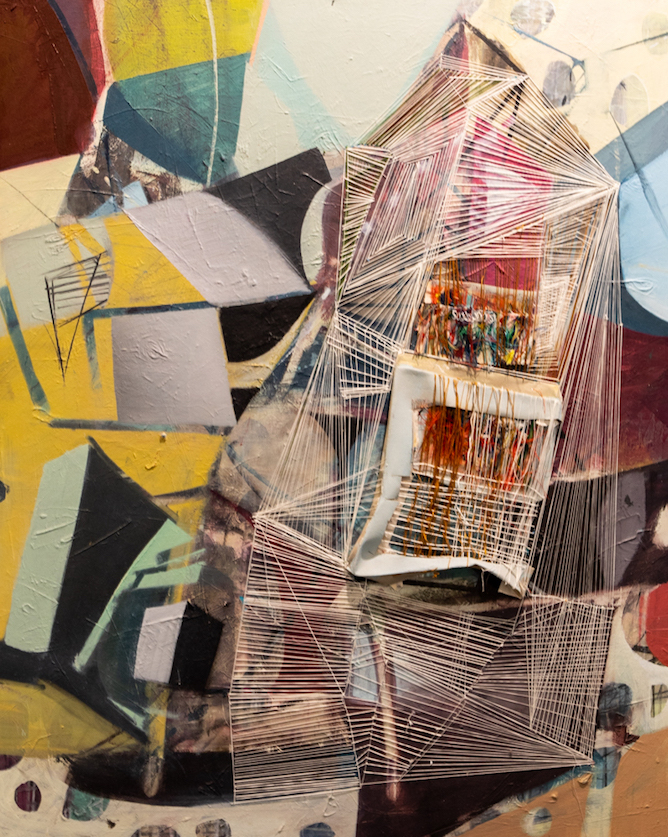
Eozen Agopian: The Fabric of Space
Greek Consulate, New York
November 15 – 30, 2018
The Fabric of Space, curated by Thalia Vrachopoulos, conveys an unusual vision by Eozen Agopian that borrows from Cubist art without in any way replicating its intensions. At first glance the similar-sized shapes in Agopian's works spark the link that soon dissolves as the intricacies of her elaborate overlapping configurations of colored fabric and skeins of thread invade one’s senses. The intelligence of these spaces and movements quickly takes precedence over the superficial initial impressions of the moment. In a city where abstract art reigns, and holdovers of gestural abstraction from the heyday of Abstract Expressionism remain intact for decades, it is a pleasure and a relief to discover an artist whose convictions are backed by the strength of her individuality.
Elaborate networks of interlocking and overlapping thread charm and captivate the eye with fleeting recollections of electrical lines or even intertwined networks of roots, maps of roads or the webs of spiders. The artist forges universal comparisons that give full play to viewer imagination and participation in the interpretation of her visually expansive orchestrated cloth ensembles. Because the works are not connected with conceptual art they are free of a planned or prescribed narrative. One may meander visually through the forest of shapes that differ in color, to contemplate their meanings. The square shape is said to symbolize matter, the earth, and stability. In Islam it denotes the heart of a normal human being open to four paths of influence, which include the human, the divine, the angelic, and the diabolic. ("1000 Symbols," p. 335, Rowena + Rupert Shepherd, Thames + Hudson.) The square forms mirror the complexities one might discover within a maquette of the human mind with its quick, shimmering apprehensions of data that are continually entering its portals
Agopian succeeds in bringing the canvas beneath the cloth labyrinths to the surface of the works via the cream and off-white colored heaps of vertically and diagonally fixed multiple mounds and hills of directed threads. Thread suggests diverse implications, from narrative literary fables to mythic fates that measure and cut the threads of an individual human life. Threads establish boundaries of alignment in the mazes of the mind. They are indiscernible transmitters of sound, light, memory and emotion. Looped and tied threads conjure intertwining associations and dependencies. Inter-winding knots appear to have no beginnings or ends, implying the process of evolution and the power of destiny. Knots combine as well as entangle. Themes of entrapment arise in the surface of the works, which do not read as morose; rather they present moderated emotions with egalitarian feeling states. Knotting and unknotting reflect the psychic method of analysis and synthesis of the threads of the individual personality. (The Book of Symbols, p. 518, Taschen.)
Fabric is often compared in literature to the "stuff" of life. Life is created through threads of experience as fabric is created through the weaving of cloth. In this sense, these works are universal metaphors for life; they resound with the richness and vibrancy of sight and touch that our senses respond most to. The artist’s small works grouped in series are especially compelling as they relate intricately with each other, as if carrying on complex conversations. There is a sense of urgent energy that flickers palpably among them.
Nets are typically symbolic of binding, capture and entanglements. In certain types of Buddhism, earthly existence is regarded as a net that entraps the human spirit. The net is also regarded as a marshalling force that transforms irreconcilable energies. Networks reference connectedness whether it applies to business, personal, social, or to communication in the World Wide Web. (The Book of Symbols, p. 518, Taschen.)
In myth and legends, the patience represented by the stitching process leads to redemption; it mends the torn fabric of the psyche and repairs the beguiled circumstances. Sewing links us to the notion of the weaving of life and the strands of fate. (The Book of Symbols, p. 460, Taschen.)
Cloth is perhaps associated historically with women who have created such things as garments, lacework, quilts, bedding, embroidery; the list goes on. But Agopian makes no move to produce careful stitchery or utilitarian or even "fine" handiwork or objects. She is a quirky artist who is having her own say in a language of her ingenious invention, much as Judy Chicago has done in 1974 - 79 in her "Dinner Party" piece. Agopian does not confine her materials to thread and cloth; she also applies paint to her works to provide a rich array of multiple medias whose interplay connects her pieces to the ebullient art of painting. The richness of the paint on the strands of the canvas provides a textural contrast, which augments the artistic revelations and historic comparisons that it stimulates. Agopian's art is tactile and visual; it appeals directly to our senses in an effective fusion of forms that reinforce the abiding power of its intelligent underpinnings.
